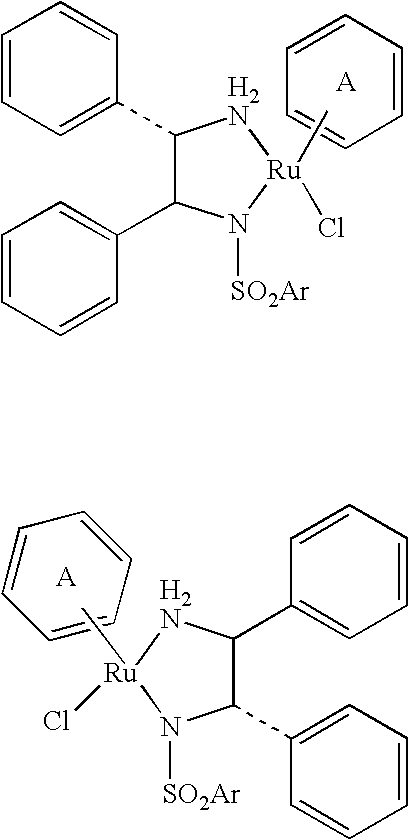Method for producing optically active amines
a technology of optically active amines and amines, which is applied in the direction of asymmetric syntheses, chemistry apparatus and processes, organic chemistry, etc., can solve the problems of difficult to obtain good optical yield, large amounts of byproducts such as alcohol compounds and n-formylamine compounds, and inconvenient methods
- Summary
- Abstract
- Description
- Claims
- Application Information
AI Technical Summary
Benefits of technology
Problems solved by technology
Method used
Image
Examples
example 1
Synthesis of (S)—N-(2-methoxy-3-dibenzofuranyl)-2-pyrrolidinecarboxamide
[0035]43.1 g of N-(tert-butoxycarbonyl)-S-proline was dissolved in 500 ml of tetrahydrofuran, and to this were added successively 20.2 g of triethylamine and 21.7 g of ethyl chlorocarbonate. The mixture was stirred at −5 to 5° C. for about 30 minutes. To the mixture was added dropwise a tetrahydrofuran solution containing 42.6 g of 3-amino-2-methoxydibenzofuran at the same temperature over about 30 minutes. Then, stirring continued at 15 to 25° C. overnight for completion of the reaction. After that, the reaction mixture was concentrated in vacuo and the residue was dissolved in ethyl acetate. The mixture was washed successively with brine, a 5% aqueous solution of sodium bicarbonate and water, and then concentrated in vacuo, to give 86.2 g of (S)-1-(tert-butoxycarbonyl)-N-(2-methoxy-3-dibenzofuranyl)-2-pyrrolidinecarboxamide as a solid. 35.0 g of the obtained compound was dissolved in 100 ml of methanol. Under ...
example 2
Synthesis of (R)-5-[2-[[2-(2-ethoxyphenoxy)ethyl]amino]propyl]-2-methoxybenzenesulfonamide (R)-mandelate
(1) Preparation of (S)-chloro[(1,2,3,4-η)-pentamethyl-2,4-cyclopentadien-1-yl][N-(2-methoxy-3-dibenzofuranyl)-2-pyrrolidinecarboxamidato-κN1, κN2]iridium(III) catalyst
[0040]79.7 mg of pentamethylcyclopentadienyl iridium(III) chloride dimer, 65.2 mg of (S)—N-(2-methoxy-3-dibenzofuranyl)-2-pyrrolidinecarboxamide and 22.3 mg of triethylamine were added to 5 ml of acetonitrile. The mixture was stirred under argon atmosphere at room temperature for about 30 minutes, to give a catalyst-containing mixture.
(2) Synthesis of (R)-5-[2-[[2-(2-ethoxyphenoxy)ethyl]amino]propyl]-2-methoxybenzenesulfonamide (R)-mandelate
[0041]4.87 g of 2-methoxy-5-(2-oxopropyl)benzenesulfonamide, 3.62 g of 2-(2-ethoxyphenoxy)ethylamine and 10 mg of sodium acetate were added to 30 ml of acetonitrile. The mixture was heated while stirred under reflux for about 1 hour. Then, the solvent was evaporated off in vacuo, ...
example 3
Synthesis of (R)-1-(4-methoxyphenyl)-2-benzylaminopropane
(1) Preparation of (R)-chloro[(1,2,3,4-η)-pentamethyl-2,4-cyclopentadien-1-yl](N-6-quinolinyl-2-pyrrolidinecarboxamidato-κN1, κN2)iridium(III) catalyst
[0048]398 mg of pentamethylcyclopentadienyl iridium(III) chloride dimer, 253 mg of (S)—N-6-quinolinyl-2-pyrrolidinecarboxamide and 111 mg of triethylamine were added to 20 ml of acetonitrile. The mixture was stirred under argon atmosphere at room temperature for about 30 minutes, to give a catalyst-containing mixture.
(2) Synthesis of (R)-1-(4-methoxyphenyl)-2-benzylaminopropane methanesulfonate
[0049]8.21 g of 4-methoxyphenyl acetone and 5.36 g of benzylamine were dissolved in 50 ml of toluene, and to this was added 50 mg of p-toluenesulfonic acid. The mixture was then dehydrated under reflux for 2 hours. The reaction mixture was concentrated in vacuo, to give 12.34 g of an imine compound as a light brown oily material. The obtained imine compound was again dissolved in 100 ml of...
PUM
 Login to View More
Login to View More Abstract
Description
Claims
Application Information
 Login to View More
Login to View More - R&D
- Intellectual Property
- Life Sciences
- Materials
- Tech Scout
- Unparalleled Data Quality
- Higher Quality Content
- 60% Fewer Hallucinations
Browse by: Latest US Patents, China's latest patents, Technical Efficacy Thesaurus, Application Domain, Technology Topic, Popular Technical Reports.
© 2025 PatSnap. All rights reserved.Legal|Privacy policy|Modern Slavery Act Transparency Statement|Sitemap|About US| Contact US: help@patsnap.com



